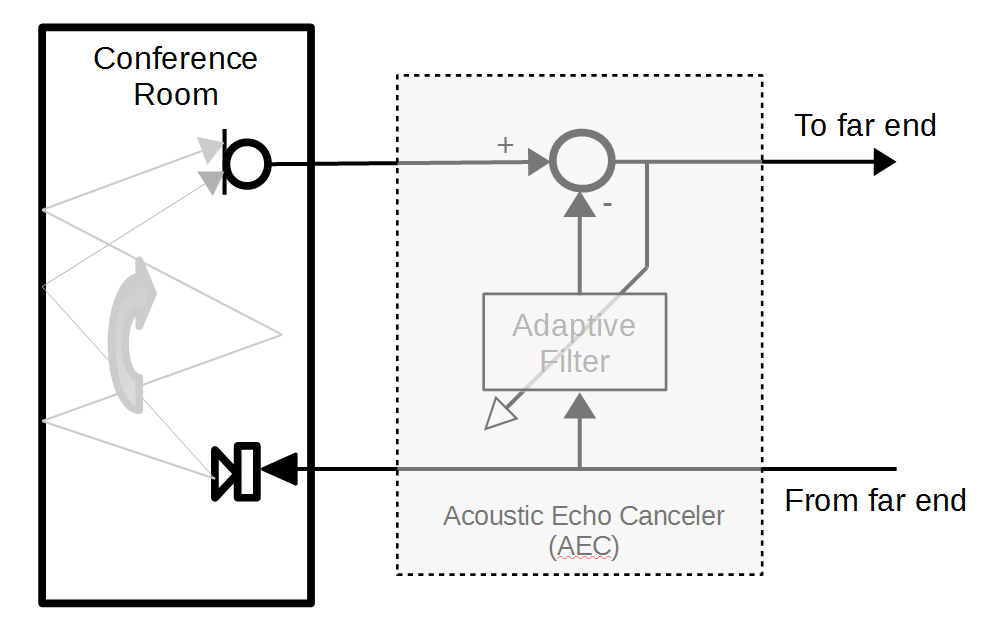|
DSP ALGORITHMS has a long history providing reliable acoustic echo cancellation solutions. Our
AEC solutions have been used in pioneering projects such as the British Telecom's VoIP client
on Windows Mobile smartphones back in 2006 when smartphones were dominated by Windows Mobile
devices. Back then smartphone application processors used to operate at maximum
speed of 200 MHz and needed to run a complete VoIP client including the AEC on top of the
Windows Mobile operating system, and all had to be responsive with good audio quality.
With today's multiple cores and GHz processors, AEC audio quality is more important than
resource consumption, and our AEC solutions have been evolving with market requirements
like no others, improving quality while keeping the robust features intact. Today, our
acoustic echo cancellation solutions are used in all communication and conferencing markets
where an AEC has an added value, from large multi-microphone installed audio systems to tiny
mobile devices.
|
|
|
|
What professionals say about our AEC Solutions
William Westlake, product manager at British Telecom after testing the Microsoft VoIP client with DSP ALGORITHMS AEC plug-in on Windows Mobile 6.0:
"The Voice Quality is now superb, better than GSM and maybe as good as PSTN."
|
|
SOURCES OF ACOUSTIC ECHO

Acoustic echo is generated whenever an application plays sound to a loudspeaker and at the same time records sound from a microphone located in the same listening space.
Examples of such applications are speakerphones, audio and video conferencing, hands-free car kits, and many others.
The figure shows one side of a full-duplex communication application in which the acoustic echo problem arises. The far-end voice signal
received from the communication channel is played through a loudspeaker. In addition to the voice of the near-end user, the microphone also picks up
sounds directly emitted from the loudspeaker and their reflections off the room walls, ceiling, floor, furniture, and other near-by objects (the acoustic echo),
as well as background noise. If nothing is done to remove this echo from the microphone signal before transmitting it, the far-end talker will hear her own
voice distorted and delayed by the communication channel. The longer the channel delay, the more annoying the echo becomes until natural conversation becomes impossible.
Full-duplex communication systems make use of an Acoustic Echo Canceller (AEC) to prevent the acoustic echo from being transmitted back to the far-end.
The AEC basically tries to estimate the echo and subtracts the estimated echo from the microphone signal as shown in the figure.
To successfully estimate the echo, an AEC makes use of an adaptive digital filter. The filter coefficients are adjusted in real-time to model the
impulse response between the loudspeaker and the microphone.
PERFORMANCE
Our AEC solution has been optimized in quality, features, and performance based on extensive field testing and valuable customer
feedback over the years. It includes advanced features that are required in modern high end conferencing and communication applications
such as fast convergence, low processing delay, robustness during double talk, microphone muting support, automatic estimation and
compensation of initial delay, performance reporting, and much more.
CODE PERFORMANCE
Efficient implementation at the algorithm level as well as at the code level resulted in unparalleled performance. For instance
a single ADSP-21489 processor
without any external memory can implement up to 8 channels of echo cancellers, each channel has 250 ms echo
tail length at 48 kHz audio sampling rate, with plenty of MIPS and memory left over for other tasks.
-
QUALITY PERFORMANCE
The sample audio files below demonstrate the audio quality of the processed speech signal during extended double-talk periods. The
female voice in the unprocessed microphone signal is the echo that must be removed, while the male voice is the voice of the local
conference participant that must be preserved. The result of processing through AEC shows how the algorithm
can remove the female voice entirely without distorting the male voice. The images show the spectral contents of the
unprocessed microphone signal and the AEC output, respectively. Click on the images for larger view.
FEATURES
- Low algorithm processing delay; defined by the user-adjustable block length.
- Supports multiple loudspeakers and multiple microphones.
- Complies fully with G.167, P.340, and VDA (category 1).
- Employs a robust and efficient block frequency domain adaptive algorithm.
- Provides superior and consistent single-talk echo reduction of 80 dB in any acoustic environments.
- Provides stable echo reduction of 40 dB or more during double-talk periods.
- Convergence rate up to 100 dB per second.
- Echo tail length is user adjustable.
- A multichannel high quality echo suppressor is also included which further reduces any remaining residual echo with negligible double-talk distortion.
- Echo suppressor can be enabled or disabled in real-time
- True Comfort Noise Generator that accurately estimates and tracks the background noise spectrum and level
- Works at any sampling frequency without any calibration or modification. It has been already deployed in top quality products running at sample rates ranging from 8kHz to 48kHz.
- Provides consistent performance in all acoustic environments.
- Trivial to integrate due to its simple Application Programming Interface.
- Fully configurable. System designers have complete control on algorithm parameters.
- Already lab and field tested on several fixed-point and floating-point processors and DSPs with and without an operating system.
- Supported on all major desktop, mobile, and embedded platforms.
- Floating-point and Fixed-point implementations optimized for several general purpose processors, microcontrollers, as well as digital signal processors are directly available.
- Proven excellent performance in many high end applications including installed audio and video conferencing, Unified Collaboration, hands-free telephones, and consumer electronics.
DEMONSTRATIONS
Several demonstration are available on different embedded, mobile, and desktop platforms.
To request one of those demonstrations please fill in this short form.
|
|